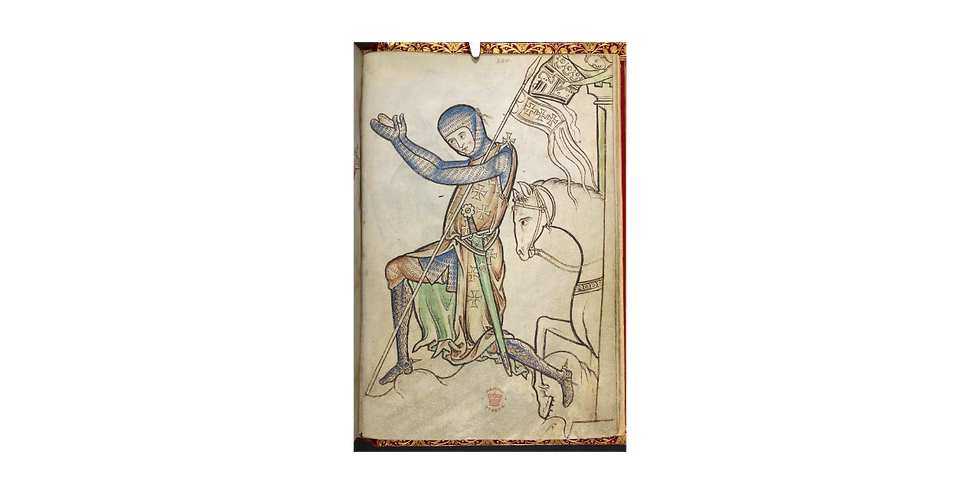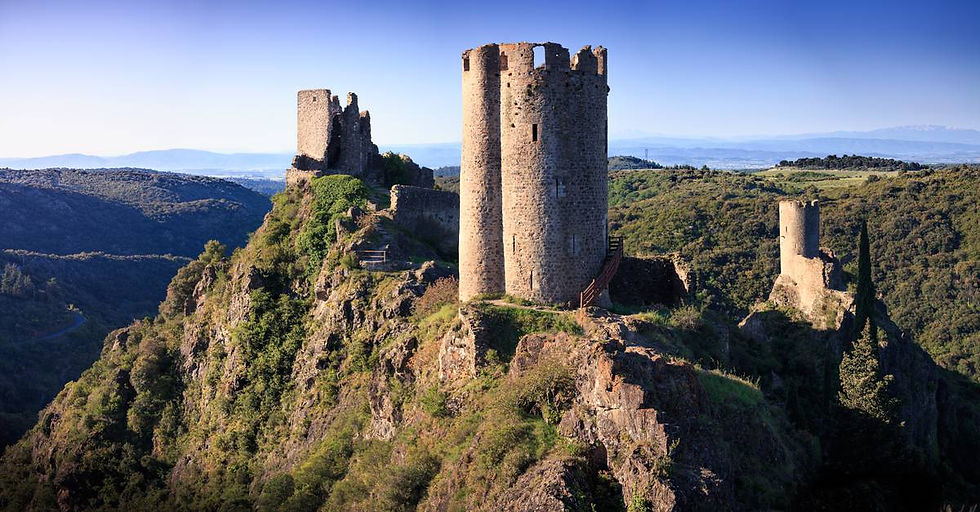Louis Pulford | Lancaster University
At midsummer 1213, Amaury de Montfort became a knight. Witnessing the proceedings was Amaury’s father, Simon de Montfort, count of Carcassonne and viscount of Beziers, his barons and his knights, who had gathered at the small town of Castelnaudary for the occasion. The crowd was so large that Simon erected pavilions on a plain outside the town to host his son’s investiture and the Mass that would follow. Simon and his wife, Alice de Montmorency, took Amaury by each hand and led him to the altar, where they requested that the bishop of Orleans appoint him a knight in the service of Christ. The bishop of Orleans, accompanied by the bishop of Auxerre, girded Amaury with the belt of knighthood and then led the congregation in the Mass.

The narrator of this event, Peter of les Vaux-de-Cernay, commented that this was a ‘novel and unprecedented form of induction into knighthood’. He was not wrong; Peter’s narrative of Amaury’s knighting subverts the thirteenth-century expectations of the knighting ritual in almost every way. Only the date of the ceremony (an important feast day, in this case, the Nativity of St John the Baptist) and the subsequent Mass were standard. According to Ramon Llull’s (1232-1315) Order of Chivalry, an initiate to knighthood had to spend the night before his dubbing keeping vigil before an altar. On the day of his dubbing, he was to come before the altar so that a secular prince could gird him with a sword and give him a kiss and a slap to remind him of charity and the great burden that he was taking up in becoming a knight. Peter’s account of Amaury’s knighting offers a very different form of elevation to knighthood. He was dubbed by a bishop, rather than by one of his secular lords as custom dictated. His father, Philip II Augustus of France, and Pedro II of Aragon all qualified for this role, although given the war between the Montforts and the Kingdom of Aragon in 1213, the latter would have been an unlikely candidate. Furthermore, Amaury was led to the altar by his parents, introducing his mother to what was a very male ritual, and no mention is made of the kiss and slap, which was such a key feature of the rite.
It could be that, in writing over fifty years after Amaury’s knighting, the ceremony that Ramon Llull describes could have drastically changed in the intervening years, but this is doubtful. The knighting ceremony, if not codified, widely took the same form from at least the twelfth century. When William Marshal came to be dubbed in 1166, he was girded by his lord and received the customary blow. In a similar fashion, and in a much more lavish ceremony, Prince Louis of France was knighted at Pentecost in 1209. Louis was girded by his father alongside the young aristocracy of France before the assembled nobility. Given that, according to the Annals of St Bertin, the most pious of the barons at Louis’ knighting were to become crusading comrades of Simon de Montfort soon after, it is possible that Amaury’s father would have been in attendance and observed this standard form of knighting. The knighting ceremony was, by 1213, an established and familiar rite of passage with which the Montfort’s and their followers would have been familiar.
Amaury’s knighting presents, therefore, a mystery to the historian. It appears to have presented a mystery to contemporaries as well. In describing the event, Peter notes that the bishops who officiated the rite only did so reluctantly and at Simon’s great urging. Despite this enigma, there has been a tendency amongst scholars to explain it away. Most have argued that, by 1213, the knighting ritual had become sacral in nature, especially amongst families involved in the crusading cause. To make the process of becoming a knight sacred was to become a holy warrior, dedicated to the service of God. Such an explanation fails to unpick the deviations from custom described in Amaury’s knighting, nor do they acknowledge the wider circumstances in which the event took place. As shall be shown below, the only way in which Amaury’s knighting can be properly understood is in the context of the great and savage undertaking of which his father was the leader – the Albigensian Crusade.

Called by Pope Innocent III in 1208 in response to the murder of his legate, the Albigensian Crusade descended upon the region of southern France known as the Midi in 1209. The crusading army’s mission, aside from fulfilling the papal desire for revenge, was to rid the area of the sect of heretics that have since come to be called the Cathars. The Cathars had been viewed as an increasingly potent threat to the spiritual health of Christendom since the mid-twelfth century. Much has been written on Cathar belief and theology, but for the purpose of understanding Amaury’s knighting, it is important to know that its deviation from Catholic orthodoxy led the Church authorities to view these heretics as an existential threat to the spiritual health of the faithful. As such, it was essential that their souls be returned to the safety of the Church, or exterminated.
The Crusade was marked by its brutality from the offset. Its first act was to descend on the town of Béziers, where, after a short siege, the townsfolk, heretic or not, were massacred. Amaury’s father, Simon, became leader of the Crusade shortly afterwards, having played a crucial role in the crusading army’s taking of Carcassonne. In the years that followed, Simon and his followers subjugated much of the Midi, and by 1213, only the great southern city of Toulouse remained in the hands of the native aristocracy. His campaigns against the Cathars and those believed to be protecting them had not lessened in their savagery. At the siege of Minerve in 1210, one-hundred-and-forty heretics were burned alive when they refused to recant their unbelief. A year later, after Simon had taken the town of Lavaur, he ordered the burning of ‘innumerable heretics’, the hanging of eighty knights who had defended the town, and that Dame of Lavaur, a known heretic, be thrown into a pit and stoned.
The rhetoric that emerged from the circle around Simon went to great efforts to justify the terror being unleashed upon the Midi and its populace. Their favoured imagery presented the region as being so stained by heresy that the land itself was infected. The bishop of Béziers wrote that so long as Toulouse, and certain other places in which ‘heretical perversity had gathered since ancient times, were not rooted out and uprooted, then a new generation of vipers and spurious calves’ would spring up again to jeopardise the southern church. Similarly, the Archbishop of Narbonne stressed the need for an axe to be laid to the ‘accursed tree’ so that its roots would cease to be a stumbling block to the faithful. Most verbose, though, was Peter of les-Vaux-de-Cernay, the narrator of Amaury’s knighting. Peter lamented that the southern heretics had sown the seeds of their unbelief throughout the land and that those bitter roots were always ready to spring up in opposition to the Church. In describing the Midi’s populace, he complained that ‘just as a bunch of grapes takes on a sickly colour from its neighbour’, or the ‘scab of a single sheep mange of one pig can destroy a whole herd’, the towns where heresy ‘had taken root were caught in the shoots… and became infected with the dreadful plague’. In this dire situation, the crusade is presented as a purifying force. The Archbishop of Arles wrote that whilst the lands around Narbonne had been ‘consumed by misery, darkness, and the shadow of death’, ‘labourers had been sent to tend to the field of the Lord and to root out the infection’. Likewise, the bishops of Bordeaux, Bazas, and Périgueux praised Simon and his crusaders, under whose care ‘the flowers of peace’ were blooming in the south. To those involved in the crusade, the brutality they were unleashing upon the Midi was an act of purification, restoring a blighted land to one of order and peace.

It is within the context of this ‘glorious purpose’ that Amaury’s knighting should be approached. The narrator, Peter of les Vaux-de-Cernay, was a member of Simon’s circle, and his Historia Albigensis offers the longest and most potent example of the rhetoric that this circle espoused. The clerical dubbing that Amaury received indicates the Montfortian ideal that they were carrying out God’s will in the south. However, it is the less commented upon but equally striking aspect of Amaury’s knighting that perhaps reveals the most when seeking to understand it – its location. Rather than being knighted in Castelnaudary’s church, as was custom, Amaury was knighted on a ‘pleasant plain’ a short distance from the town. Castelnaudary, whilst not as malevolent as Toulouse, Carcassonne or Béziers, had ‘secretly obstructed Christ’s business as much as they could’. Indeed, Peter narrates how, in 1210, the occupants of the town had denied entry to a group of crusaders in order to protect its heretics and forced them to camp beyond the town. In leaving the town to knight Amaury, the crusading army was leaving behind the town’s wickedness in order to carry out the sacred process of making him a knight.
As explored above, the beginning of the Historia saw Peter narrate how the Midi had been caught up in ‘the shoots put out by unbelief and became infected by the dreadful plague’. The occupants of the landscape were diseased with a ‘worthless animal cunning, earthly and devilish in its nature’. The description of the Crusade’s moral environment at the start of the Historia presents a landscape inhabited by beasts, demons, and devoid of peace. By the time Peter came to describe Amaury’s knighting, however, he saw fit to describe the land around Castelnaudary, a town known for its heretical belief, as pleasant. In this, it is possible that Peter was demonstrating to his audience the impact of the crusade. Whereas, before the coming of the crusade, the land had been consumed by chaos and immorality, the rural landscape had been reclaimed by the efforts of Simon de Montfort and his followers. Whilst many of the region’s towns and cities were still refuges of perversity and heresy, the crusade was successfully restoring order to the countryside, creating a pleasant landscape out of wilderness.
It is in this way that the knighting of Amaury de Montfort should be understood. In his narration of the event, Peter of les Vaux-de-Cernay took what may have been a bizarre event and imbued it with significance. He used Amaury’s knighting to demonstrate how, under the leadership of the Montfort family, the Albigensian Crusade was successfully restoring the spiritual health of the Midi, cultivating a purer landscape where the faith could thrive.
Further Reading:
Peter of les Vaux-de-Cernay, The History of the Albigensian Crusade, trans. by W.A. Sibly and M.D. Sibly (Woodbridge: The Boydell Press, 1998)
William of Tudela and an Anonymous Successor, The Song of the Cathar Wars, a History of the Albigensian Crusade, trans. by J. Shirley (London: Ashgate Publishing Company, 2000)
S. T. Ambler, The Song of Simon de Montfort, England’s First Revolutionary and the Death of Chivalry (London: Picador, 2019)
M. Keen, Chivalry (New Haven: Yale University Press, 1984)
J. Sumption, The Albigensian Crusade (London: Faber & Faber, 1978)
The Rest is History, The Mystery of the Cathars (7 February, 2023)
Louis Pulford is an Early Career Researcher whose research focuses on historical writing in the thirteenth century, especially that which focused on the series of wars known as the Albigensian Crusade (1209-1244). He undertook his doctoral research at Lancaster University and has also studied at the University of East Anglia.